Who needs fireworks when you’ve got a lunar eclipse?

Skywatchers in much of Canada and the United States will be treated to a penumbral lunar eclipse on U.S. Independence Day, just before the full “buck moon” rises late on July 4 and early July 5.
The penumbral lunar eclipse will appear as a shadow cast by the Earth onto the edge of the moon Saturday night and into Sunday morning. It will look like a foggy darkness over part of the lunar face.
The eclipse will start at 11:07 p.m. EDT (8:07 p.m. PDT) on Saturday night and last for about 2 hours and 45 minutes, according to NASA’s projections. The eclipse will reach its height at 12:31 a.m. EDT (9:31 PDT) on Sunday, when it will veil about one-third of the moon in the sky.
The entire penumbral lunar eclipse will be visible to Canadians in Ontario and provinces east of it, and for the vast majority of Americans. Skywatchers in southern Manitoba and Saskatchewan will be able to see the start of the eclipse, but Canadians in the west will have to catch the eclipse in progress when the moon rises in their area.

Get daily National news
The entirety of the penumbral eclipse will also visible to skywatchers in Central and South America. The eclipse will not be visible from Alaska or the northern territories, except along their southernmost edges.
A full searchable map of the eclipse’s path is available at TimeandDate.com.

Skywatchers can expect a “subtle” view at best, according to the website EarthSky. Penumbral lunar eclipses tend not to be as spectacular as partial or full eclipses.
A lunar eclipse occurs when the Earth comes between the moon and the sun so that it casts a shadow. The most concentrated part of that shadow is called the umbra, while the lighter edges of the shadow are called the penumbra. In the case of this weekend’s occurrence, the moon will pass partially through the Earth’s penumbra, which isn’t dark enough to totally obscure it.
The moon will become full early on Sunday morning. Western folklore awards a name to the first full moon of each month, and the one in July is known as the “buck” moon.
Another penumbral lunar eclipse is expected in the west on Nov. 30 of this year, but there are no partial or total eclipses on the calendar for the remainder of 2020.
The next total lunar eclipse is expected on May 26, 2021, according to NASA data.
- Teen suspect claims no memory of stepsister’s cruise ship death, documents say
- Severe atmospheric river storm causes flooding, mudslides in Southern California
- Powerball player claims $1.817 billion lottery jackpot in Arkansas
- DOJ finds over a million potentially relevant Epstein files, delays release








Comments